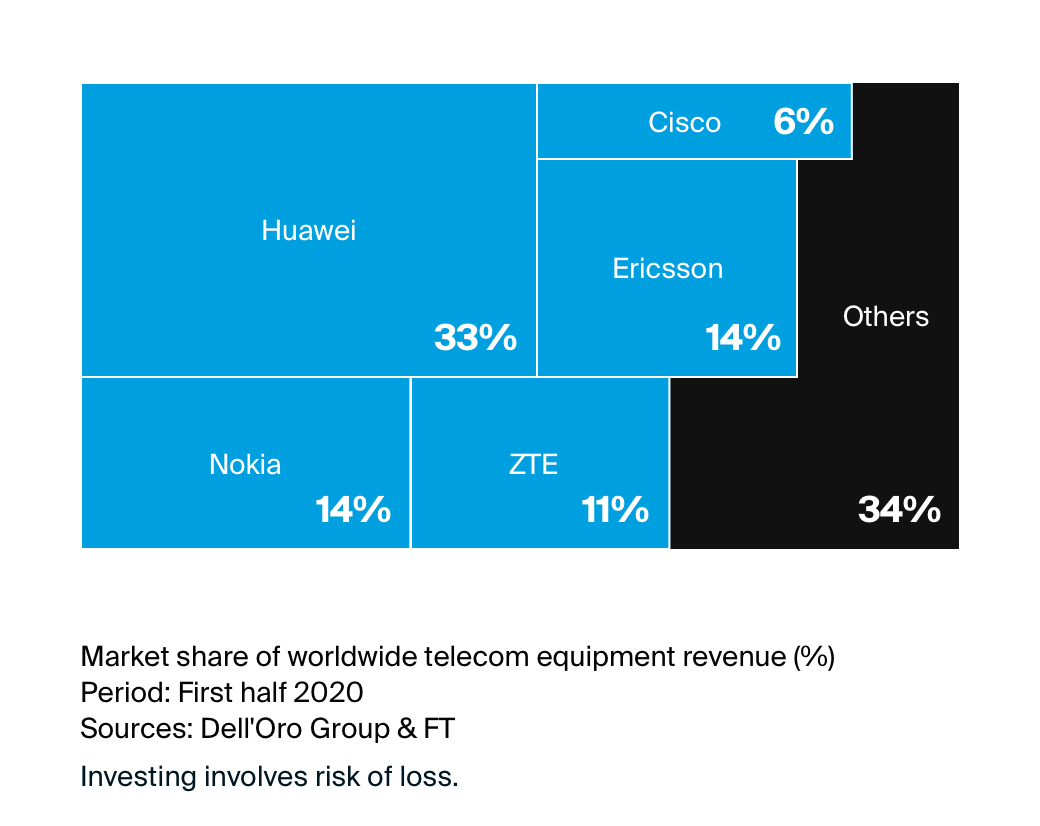5G technology has the possibility to revolutionise industries as we know them all around the world. 5G networks began rolling out around the world in 2018, however, we are still in the early days of the technology. In the future, for example, 5G technology will enhance widespread use of autonomous vehicles and even enable telesurgery in which doctors orchestrate surgeries remotely and robots perform them locally. It will be years before such achievements are made, but after years of hype, 5G is starting to become a reality with 5G networks being rolled out in parts of the world and 5G devices hitting the market.
In this article, we discuss what 5G is, how you can invest in it and the companies that have the biggest market share in the 5G telecom equipment industry.
What is 5G?
5G stands for fifth-generation mobile networks and is the successor to 4G, which is the current standard of cellular networks. Before 4G was 3G, which enabled internet on mobile devices, and before that was 2G, which enabled voice-only capabilities. Some of the advantages of 5G are:
- Fast: 5G has the possibility to be up to 100 times faster than 4G networks’ speed. A movie download that would take minutes with 4G would just take seconds with 5G.
- Low latency: This means that there is little delay in time in which signals are sent and received. 5G latency will be faster that human visual processing and remote devices will be able to be controlled in near-real time.
- More capacity: 5G could offer up to 1,000 times more capacity than 4G, which fosters Internet of Things (IoT) development. Simply put, IoT is the concept of connecting devices to the internet. This includes everything from cellphones to washing machines.
- Increased bandwidth: With increased speed and network capacity, 5G networks will make it possible for more data to be transmitted compared to 4G. It will be able to handle more connected devices, so you would no longer have spotty service in crowded areas such as a football stadium.
Ways to invest in 5G
There are many ways in which you can add 5G to your portfolio. A more direct approach is investing in companies involved in the 5G supply chain. Below are some parts of the supply chain and examples of companies in that sector:
- Communication towers:: 5G will require more cell towers and antennas compatible with 5G to ensure reliability. Some telecommunication companies build and operate their own towers. However, according to Morgan Stanley, a growing amount of the business is going to independent tower companies, also known as towercos. These companies generate revenue by leasing space on their sites to wireless carriers. Examples in this case are real estate investment trusts (REITs): American Tower and Crown Castle International.
- Equipment makers: Companies that produce telecommunications equipment are, of course, essential for 5G. Telecom equipment includes broadband access, microwave and optical transport, mobile core and radio access network (RAN), SP routers and carrier ethernet switches (CES). Examples of equipment vendors are Nokia and Ericsson.
- Device manufacturers: Most of the 5G devices that are currently available on the market are “backward compatible”, which means they can function on earlier generation networks outside of 5G. However, 5G will not work on existing devices made for 3G or 4G. Examples of device manufacturers are Apple and Samsung.
- Service carriers: These companies supply cellular connectivity services to mobile devices. They operate and own infrastructure in areas and regions where they offer their services. Some carriers, including Verizon and AT&T, have already rolled out 5G coverage in certain areas.
Top 5G vendors
Dell’Oro Group, a research company cited by Bloomberg and the Financial Times, published a report indicating the 5G equipment suppliers with the biggest global market share. During the first half of the year, the majority of 5G telecom equipment revenue worldwide came from Chinese and Scandinavian companies:

The information in this article is not written for advisory purposes, nor does it intend to recommend any investments. Please be aware that facts may have changed since the article was originally written.
Sources: FT, Motley Fool, Intel, CNN, Business Insider, Morgan Stanley, Business Insider, Federal Communications Commission, Samsung, New York Times



